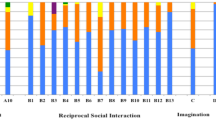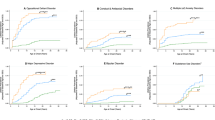Abstract
Autistic symptoms are frequently observed in children with attention-deficit/hyperactivity disorder (ADHD), but their etiology remains unclear. The main aim of this study was to describe risk factors for increased autistic symptoms in children with ADHD without an autism or autism-spectrum diagnosis. Comorbid psychiatric disorders, developmental delay, current medication, prenatal biological and postnatal psychosocial risk factors as well as parental autistic traits were assessed in 205 children with ADHD. Linear regression models identified maternal autistic traits, current familial risk factors and hyperactive symptoms as predictors of autistic symptoms in children with ADHD. Findings are indicative of possible genetic as well as environmental risk factors mediating autistic symptoms in children with ADHD. An additional validity analysis by ROC, area under the curve (AUC), suggested a cut-off of 11 to differentiate between ADHD and high-functioning ASD by the Social Communication Questionnaire (SCQ).

Similar content being viewed by others
References
Rommelse NN, Altink ME, Fliers EA, Martin NC, Buschgens CJ, Hartman CA, Buitelaar JK, Faraone SV, Sergeant JA, Oosterlaan J (2009) Comorbid problems in ADHD: degree of association, shared endophenotypes, and formation of distinct subtypes. Implications for a future DSM. J Abnorm Child Psych 37:793–804
Mulligan A, Anney RJ, O’Regan M, Chen W, Butler L, Fitzgerald M, Buitelaar J, Steinhausen HC, Rothenberger A, Minderaa R, Nijmeijer J, Hoekstra PJ, Oades RD, Roeyers H, Buschgens C, Christiansen H, Franke B, Gabriels I, Hartman C, Kuntsi J, Marco R, Meidad S, Mueller U, Psychogiou L, Rommelse N, Thompson M, Uebel H, Banaschewski T, Ebstein R, Eisenberg J, Manor I, Miranda A, Mulas F, Sergeant J, Sonuga-Barke E, Asherson P, Faraone SV, Gill M (2009) Autism symptoms in attention-deficit/hyperactivity disorder: a familial trait which correlates with conduct, oppositional defiant, language and motor disorders. J Autism Dev Disord 39:197–209
Frazier JA, Biederman J, Bellordre CA, Garfield SB, Geller DA, Coffey BJ, Faraone SV (2001) Should the diagnosis of attention-deficit/hyperactivity disorder be considered in children with pervasive developmental disorder? J Atten Disord 4:203–211
Polanczyk G, Lima MS, de Horta BL, Biederman J, Rohde LA (2007) The worldwide prevalence of ADHD: a systematic review and metaregression analysis. Am J Psychiatry 164:942–948
Chakrabarti S, Fombonne E (2005) Pervasive developmental disorders in preschool children: confirmation of high prevalence. Am J Psychiatry 162:1133–1141
Baird G, Simonoff E, Pickles A, Chandler S, Loucas T, Meldrum D, Charman T (2006) Prevalence of disorders of the autism spectrum in a population cohort of children in South Thames: the Special Needs and Autism Project (SNAP). Lancet 368:210–215
Simonoff E, Pickles A, Charman T, Chandler S, Loucas T, Baird G (2008) Psychiatric disorders in children with autism spectrum disorders: prevalence, comorbidity, and associated factors in a population-derived sample. J Am Acad Child Adolesc Psychiatry 47:921–929
Nijmeijer JS, Minderaa RB, Buitelaar JK, Mulligan A, Hartman CA, Hoekstra PJ (2008) Attention-deficit/hyperactivity disorder and social dysfunctioning. Clin Psychol Review 28:692–708
American Psychiatric Association (ed) (2000) DSM-IV-TR. Diagnostic and statistical manual of mental disorders, Am Psychiatric Ass, Washington DC
The ICD-10 classification of mental and behavioural disorders. Clinical descriptions and diagnostic guidelines (1992) World Health Organization, Geneva
Solanto MV, Pope-Boyd SA, Tryon WW, Stepak B (2009) Social functioning in predominantly inattentive and combined subtypes of children with ADHD. J Atten Disord 13:27–35
DuPaul GJ, McGoey KE, Eckert TL, VanBrakle J (2001) Preschool children with attention-deficit/hyperactivity disorder: impairments in behavioral, social, and school functioning. J Am Acad Child Adolesc Psychiatry 40:508–515
Da Fonseca D, Seguier V, Santos A, Poinso F, Deruelle C (2009) Emotion understanding in children with ADHD. Child Psychiatry Hum Dev 40:111–121
Clark T, Feehan C, Tinline C, Vostanis P (1999) Autistic symptoms in children with attention deficit-hyperactivity disorder. Eur Child Adolesc Psychiatry 8:50–55
Kochhar P, Batty MJ, Liddle EB, Groom MJ, Scerif G, Liddle PF, Hollis CP (2011) Autistic spectrum disorder traits in children with attention deficit hyperactivity disorder. Child Care Health Dev 37:103–110
Reiersen AM, Constantino JN, Volk HE, Todd RD (2007) Autistic traits in a population-based ADHD twin sample. J Child Psychol Psychiatry 48:464–472
Ronald A, Simonoff E, Kuntsi J, Asherson P, Plomin R (2008) Evidence for overlapping genetic influences on autistic and ADHD behaviours in a community twin sample. J Child Psychol Psychiatry 49:535–542
Lichtenstein P, Carlstrom E, Rastam M, Gillberg C, Anckarsater H (2010) The genetics of autism spectrum disorders and related neuropsychiatric disorders in childhood. Am J Psychiatry 167:1357–1363
Nijmeijer JS, Hoekstra PJ, Minderaa RB, Buitelaar JK, Altink ME, Buschgens CJ, Fliers EA, Rommelse NN, Sergeant JA, Hartman CA (2009) PDD symptoms in ADHD, an independent familial trait? J Abnorm Child Psych 37:443–453
Santosh PJ, Mijovic A (2004) Social impairment in hyperkinetic disorder—relationship to psychopathology and environmental stressors. Eur Child Adolesc Psychiatry 13:141–150
Reiersen AM, Constantino JN, Todd RD (2008) Co-occurrence of motor problems and autistic symptoms in attention-deficit/hyperactivity disorder. J Am Acad Child Adolesc Psychiatry 47:662–672
Rutter M, Bailey A, Lord C (2003) The social communication questionaire manual, Western Psychological Services, Los Angeles
Berument SK, Rutter M, Lord C, Pickles A, Bailey A (1999) Autism screening questionnaire: diagnostic validity. Br J Psychiatry 175:444–451
Bölte S, Crecelius K, Poustka F (2000) The Questionnaire on Behaviour and Social Communication (VSK): an autism screening instrument for research and practice. Diagnostica 46:149–155
Rühl D (2004) ADOS. Diagnostische Beobachtungsskala für autistische Störungen; Manual; [dt. Fassung der Autism diagnostic observation schedule], Huber, Bern
Unnewehr S, Schneider S, Margraf J (1995) Diagnostisches Interview bei psychischen Störungen im Kindes‐ und Jugendalter (Kinder‐DIPS) (1. Auflage). Springer, Berlin
Lehmkuhl G (2003) Diagnostik-System für psychische Störungen im Kindes- und Jugendalter nach ICD-10 und DSM-IV. DISYPS-KJ; klinische Diagnostik—Elternurteil—Erzieher- und Lehrerurteil—Selbsturteil; Manual. Huber, Bern
Schneider S, Unnewehr S, Margraf J (2009) Kinder‐DIPS für DSM‐IV‐TR. Diagnostisches Interview bei psychischen Störungen im Kindes‐ und Jugendalter (2. erweiterte und vollständig überarbeitete Auflage). Springer, Heidelberg
Melchers P, Preuß U (2001) Kaufman assessment battery for children, German version. Hogrefe Verlag, Göttingen
Petermann F, Petermann U (2000) Hamburg–Wechsler-Intelligenztest für Kinder III. German Version. Hogrefe Verlag, Göttingen
Weiß RH (2008) Grundintelligenztest Skala 2—Revesion (CFT-20-R), Hogrefe, Göttingen
Bulheller S, Häcker H (2006) Ravens`s progressive matrices and vocabulary scales. deutsche Version. Harcourt, Frankfurt
Freitag CM, Retz-Junginger P, Retz W, Seitz C, Palmason H, Meyer J, Rosler M, von Gontard A (2007) German adaptation of the autism-spectrum quotient (AQ): evaluation and short version AQ-k. Z Klin Psychol Psychother 36:280–289
Rosler M, Retz W, Retz-Junginger P, Thome J, Supprian I, Nissen T, Stieglitz R D, Blocher D, Hengesch G, Trott GE (2004) Tools for the diagnosis of attention-deficit/hyperactivity disorder in adults. Self-rating behaviour questionnaire and diagnostic checklist. Nervenartzt 75: 888+
Poustka F, Burk B, Baestlein M, von Goor-Lambo G, Schermer D (1994) Elterninterview zur Achse V des Multiaxialen Klassifikationsschemas für psychiatrische Erkrankungen im Kindes- und Jugendalter: Assoziierte aktuelle abnorme psychosoziale Umstände (Lifetime-Version), Swets Tests, Frankfurt
von Goor-Lambo G (1987) The reliability of axis V of the multiaxial classification scheme. J Child Psychol Psychiatry 28:597–612
Lord C, Rutter M, Lecouteur A (1994) Autism Diagnostic Interview-Revised—a revised version of a diagnostic interview for caregivers of individuals with possible pervasive developmental disorders. J Autism Dev Disord 24:659–685
Freitag CM, Agelopoulos K, Huy E, Rothermundt M, Krakowitzky P, Meyer J, Deckert J, von Gontard A, Hohoff C (2010) Adenosine A(2A) receptor gene (ADORA2A) variants may increase autistic symptoms and anxiety in autism spectrum disorder. Eur Child Adolesc Psychiatry 19:67–74
Bölte S, Rühl D, Schmötzer G, Poustka F (2006) Diagnostisches Interview für Autismus—revidiert. ADI-R; deutsche Fassung des autism diagnostic interview—revised (ADI-R) von M. Rutter, A.Le Couteur und C. Lord; Manual, Huber; Hogrefe, Göttingen
Tellegen PJ, Laros JA, Petermann F (2007) SON-R 2 1/2-7. Nonverbaler Intelligenztest, Göttingen, Hogrefe Verlag
Tabachnik BG, Fidell LS (2007) Using Multivariate Statistics, Pearson International Education, Boston
Belsley DA, Kuh E, Welsch RE (1980) Regression diagnostics: identifying influential data and sources of collinearity. Wiley, New York
Ho DE, Imai K, King G, Stuart EA (2007) Matching as nonparametric preprocessing for reducing model dependence in parametric causal inference. Political Anal 15:199–236
Ho DE, Imai K, King G, Stuart EA (2009) MatchIt: nonparametric preprocessing for parametric causal inference. http://gking.harvard.edu/matchit/. Accessed 16.06.2011
Ronald A, Hoekstra RA (2011) Autism spectrum disorders and autistic traits: a decade of new twin studies. Am J Med Genet B Neuropsychiatr Genet 156B:255–274
Freitag CM (2007) The genetics of autistic disorders and its clinical relevance: a review of the literature. Mol Psychiatry 12:2–22
Freitag CM, Hänig S, Schneider A, Seitz C, Palmason H, Retz W, Meyer J (2011) Biological and psychosocial environmental risk factors influence symptom severity and psychiatric comorbidity in children with ADHD. J Neural Transm (in press)
Allen CW, Silove N, Williams K, Hutchins P (2007) Validity of the social communication questionnaire in assessing risk of autism in preschool children with developmental problems. J Autism Dev Disord 37:1272–1278
Cohen J (1992) A power primer. Psychol Bull 112:155–159
Acknowledgments
We thank the children and parents taking part in this study. This study was supported by the Deutsche Forschungsgemeinschaft (ME 1923/5-1, ME 1923/5-3, GRK 1389/1) and by the Saarland University (T6 03 10 00 – 45).
Conflict of interest
None.
Author information
Authors and Affiliations
Corresponding author
Rights and permissions
About this article
Cite this article
Kröger, A., Hänig, S., Seitz, C. et al. Risk factors of autistic symptoms in children with ADHD. Eur Child Adolesc Psychiatry 20, 561–570 (2011). https://doi.org/10.1007/s00787-011-0221-1
Received:
Accepted:
Published:
Issue Date:
DOI: https://doi.org/10.1007/s00787-011-0221-1




